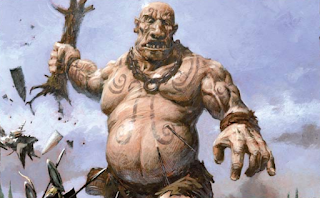Warhammer Fantasy Roleplay: Old World Bestiary
Published by Cubicle 7 (Black Industries 2005)
Design and Writing by T.S. Luikart and Ian Sturrock
Development and Rules Design by Chris Pramas
Warhammer Fantasy Roleplay 2nd edition's bestiary appropriately reflects the spirit of the game: familiar tropes from a murkier perspective. Patching up the core rulebook's lackluster adversary section, Old World Bestiary provides rules for most of the vicious and strange creatures that populate the tabletop wargame.
 |
| Cubicle 7 |
In many ways it's a standard take on one of the classic RPG staples but the book is set apart by its framing. Divided between a player and game master section, the former is presented through an in-universe document, Perilous Beasts. An assortment of rumors and scholarly debate, with a healthy dose of ravings and hearsay, it collects what characters in the setting know about the beings inhabiting dark corners of the world.
Even the more authoritative sections are shrouded by uncertainty, with a letter at the end calling the entire work into question.
It's a brilliant literary device and one that fits the lopsided, "Ratcatcher" tone of WFRP perfectly. Information that would be common knowledge to most players is often unclear at best to
even the most educated characters within the setting.The quotes that make up most of the player's section are what you'd expect from Warhammer - at times dry accounts of warriors clashing. But that's tempered with the setting's offbeat humor, as best shown by the constant repertoire of a Skaven assassin curtly noting the best poison to use against each creature, in contrast with the other winding anecdotes.
Old World Bestiary also throws in information to make fans familiar with the setting second guess themselves. Do wyverns really inflict bad luck on those unfortunate enough to meet one? The way in-universe beliefs cloud the truth plays into the broader themes of WFRP, with its tarnished heroes and bloody codes built on lies.
For example, Chimeras are agreed to be monstrous fusions of natural animals warped by the Chaos gods' dark influence, in contrast with the noble Griffon, the symbol of the Empire and therefore beyond reproach.
 |
| Cubicle 7 |
The best moments are as always when emotional moments sprout up in this world of heavy metal style artwork and large hats. Some of the tales are haunting or strangely touching and Old World Bestiary reveals that even the monstrous can possess a measure of humanity, as creatures who can speak for themselves are given a chance to.
But even with more sensitive moments slipped in there's a very militant bent to the book. The Enemy Within's assertion that mutants are victims of society, who's monstrous state is a result of being constantly threatened with extermination feels long gone by this point.
There are no surprising mix ups or radical additions here, not to Warhammer's established menagerie or the usual fantasy fare. Orcs, beastmen, ogres, dragons, trolls, Chaos Daemons and the like fill the pages. Old World Bestiary is almost exclusively focused on what players would likely encounter in the titular Old World, roughly equivalent to Europe. A few fan favorites are slipped in to mix it up, notably the at the time semi-dormant Chaos Dwarfs.
The game master's section is the real deal - which is to say stat blocks and briefer descriptions that aren't so ambiguous. Not personally what I find interesting about the book but admittedly that's normally what you buy a bestiary for. New rules are introduced to help accurately represent some of the more complex creatures, namely daemons and the many variants of vampires, where each bloodline is represented despite receiving their own book with Night's Dark Masters.
Arranged alphabetically in contrast with the more narrative grouping of the player section, it's clean and easy to use. While not revolutionary, I do appreciate the restraint shown with the stat blocks. Everything feels in line with established background. In contrast with its deep space counterpart Creatures Anathema, which had much stranger and more daring ideas, Old World Bestiary avoids relying too heavily on unique mechanics to differentiate creatures.
 |
| Cubicle 7 |
Like most of WFRP 2E, art wise it's a mixed bag . Plenty of artwork is recycled, which I can mostly overlook. I personally think Adrian Smith, Karl Kopinski, and the rest of that era's wargame illustrators produced the gold standard of Warhammer art.
The original artworks are much more of a mixed bag, with plenty feeling overly generic or sloppy, though a few bright spots are mixed in. Overall, I have to say Old World Bestiary's art often lacks personality, a poor fit for a publication otherwise bursting with it.
A relatively straightforward and competent book presented in a unique way, Old World Bestiary set the bar for me in its particular genre. Only a few other RPG bestiaries come close to treating its monsters as an active part of the setting and its cultures instead of just stat blocks to be whacked at.

No comments:
Post a Comment